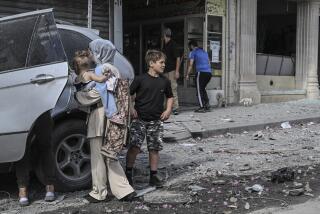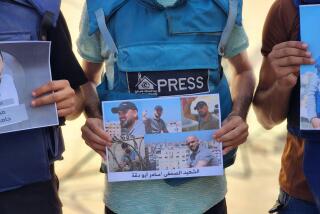NEWS ANALYSIS : Support for War Seen Despite Baghdad Deaths : Public opinion: Heavy civilian casualties in earlier wars saddened Americans but did not greatly change their view of those conflicts.
- Share via
WASHINGTON — Americans were horrified and saddened when U.S. troops bombed Hiroshima and Dresden in World War II, pounded Hanoi in the Vietnam War and leveled part of the impoverished neighborhood of Chorrillo during the 1989 invasion of Panama.
But civilian casualties were not enough to change Americans’ views of those conflicts, and many public opinion analysts believe the same may be true with this week’s report that a U.S. strike killed scores of civilians inside a Baghdad structure that Iraq described as a bomb shelter.
While videotapes of some of the casualties have deeply disturbed many Americans, the incident--and the prospect of more like it--probably would not be enough to significantly erode support for the war that has remained consistently strong, many predict.
“American casualties can quickly cut public support, but, for better or for worse, we just don’t react the same way when it’s foreign civilians,” said Prof. Gary Orren, public opinion analyst at Harvard University’s John F. Kennedy School of Government.
That does not mean that U.S. reaction to the Baghdad casualties is not strong. Several anti-war groups cited the bombing Thursday as they renewed calls for an end to hostilities. One group, the Atlantic Life Community, splashed a Pentagon door with blood and oil during a sit-in of about 50 people.
The news of the incident was shocking, some observers said, because American officials had suggested so strongly that their high-tech weaponry could execute “surgical” strikes, avoiding heavy civilian casualties.
“This will bring people back to the reality that no matter how you try to sanitize it, war is about the deaths of innocent people,” said Rep. Maxine Waters (D-Los Angeles), who said she has heard from many of her constituents about the bombing.
Public opinion pollsters have yet to conduct surveys that will show exactly how Americans have reacted to the incident.
But some analysts speculated the polls will show that many Americans accept the Pentagon’s assertions that the bombed building was targeted as a structure that housed a key military communications center. Others will say that civilian casualties are unavoidable in war and that they are justifiable to stop a man like Saddam Hussein, who is responsible for the killings of many civilians during and before the war, analysts said.
“The public believes that it has large and pressing interests at issue in this war, and it has carefully thought all of this out,” said Everett C. Ladd, director of the Roper Center for Public Opinion Research, at the University of Connecticut.
Surveys conducted in recent days indicate that seven Americans in 10 support President Bush’s handling of the Persian Gulf War, down slightly from polls of about two weeks ago.
In other wars of the past half century, there has been no clear correlation between heavy civilian casualties and the level of public support. Indeed, public approval generally has not fallen, even temporarily, after news of a devastating attack on civilians, analysts said.
The biggest civilian casualty toll of this century came during World War II, in which 15 million soldiers and 34 million civilians were killed. That was a dramatic increase from World War I.
American forces inflicted terrible losses during World War II in firebombing raids on Germany and Japan. One assault, on Tokyo, killed more than 100,000 people. Yet polls taken at the time showed that more than nine out of 10 Americans believed that Germany and Japan had brought the devastation on themselves, opinion analysts said. Even after the firebombing raids--and the dropping of nuclear bombs on Hiroshima and Nagasaki--the level of support did not decline materially, analysts said.
“Support remained firm all the way through,” said John Mueller, professor of political science at the University of Rochester.
During the Korean War, U.S troops suffered huge casualties in 1950, the first year of fighting. Political support peaked in the fall of 1950, when about 80% of Americans said they believed the government was correct in its decision to send troops to Korea.
By 1953, support had fallen to about 40%. Yet analysts said the decline was directly related to reports of U.S. casualties and was largely unaffected by grisly reports of civilian casualties that occurred as Seoul changed hands again and again between troops of the United Nations and those of North Korea.
Likewise, public disaffection with the Vietnam War was tied to the growing number of U.S. casualties and to the increased perception that Washington’s repeated claims of military success were not true. The public generally supported the war until the end of 1967,when backing began to slip.
The bombing of Hanoi in 1972 and the massacre of 347 civilians by U.S. troops at My Lai “added to the momentum against the war but didn’t create it,” said Prof. Richard Brody, a public opinion analyst at Stanford University.
Indeed, several highly publicized accounts of civilian casualties relatively early in the war prompted widespread discussion but did not by themselves cause public perceptions of the conflict to shift significantly.
One was a 1965 CBS News report about U.S. troops using cigarette lighters to set fire to Vietnamese villages. Another was a series of 1966 New York Times reports on the bombing of Nam Dinh, a textile-producing center in the Red River Delta, that the North Vietnamese said eventually flattened 60% of the city’s buildings.
Though the stories were terrible, “you couldn’t find any change in public opinion,” said the University of Rochester’s Mueller.
THE HUMAN COST OF WAR
While wars are fought between armies, the toll is frequently greatest on civilian bystanders. Statistics compiled by the Lentz Peace Research Laboratory tell the chilling story: In wars and war-related turmoil since 1945, more than 13.3 million civilians have died, nearly double the number of military deaths. MAJOR WARS WITH U.S. INVOLVEMENT
CIVILIAN MILITARY YEARS DEATHS DEATHS World War I 1914-18 6,642,633 8,020,780 World War II 1939-45 26 million-34 million 15 million Korea 1950-53 1.5 million 1.5 million Vietnam 1965-75 1.0 million 1.06 million
SOME KEY CONFLICTS SINCE 1945
CIVILIAN MILITARY YEARS DEATHS DEATHS Iran-Iraq War 1980-88 100,000 900,000 Afghanistan-USSR 1978-89 670,000 55,000 Cultural Revolution (China) 1967-68 450,000 50,000 Lebanon 1975-89 115,000 47,000 Angola Civil War 1975-89 230,000 21,000 El Salvador 1979-89 47,000 18,000 Argentina-U.K. (Falklands) 1982 0 1,000
Sources: World Military and Social Expenditures--1987-88, 1989; Encyclopedia of Military History
More to Read
Sign up for Essential California
The most important California stories and recommendations in your inbox every morning.
You may occasionally receive promotional content from the Los Angeles Times.













